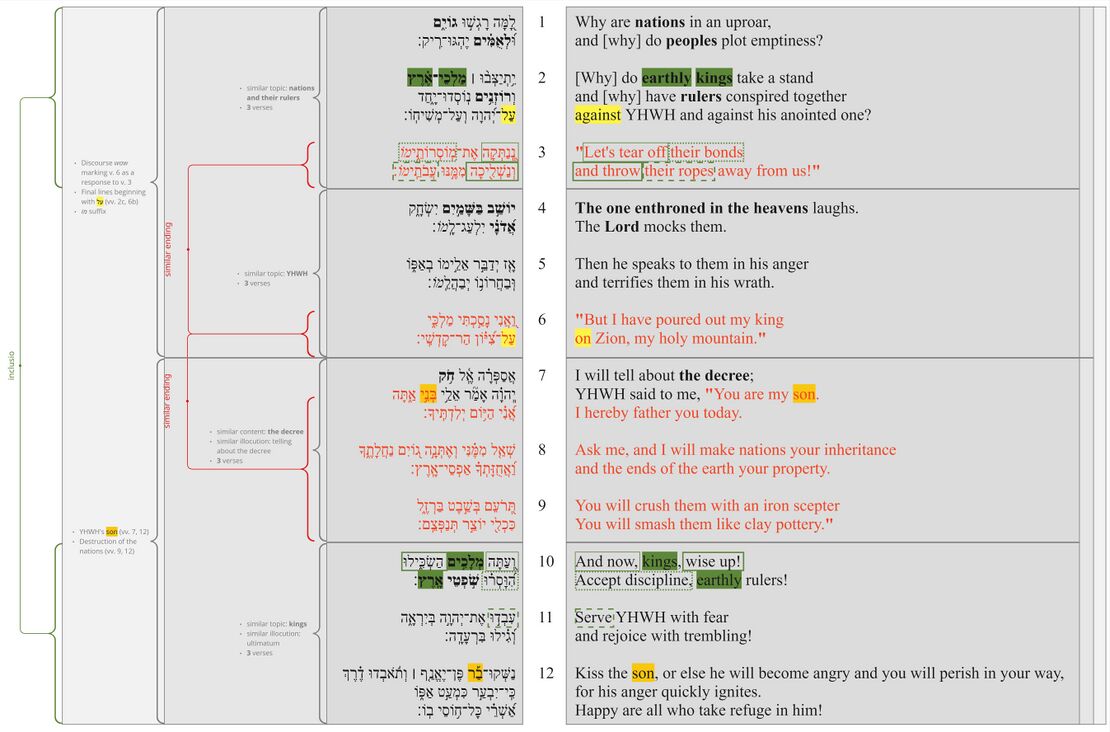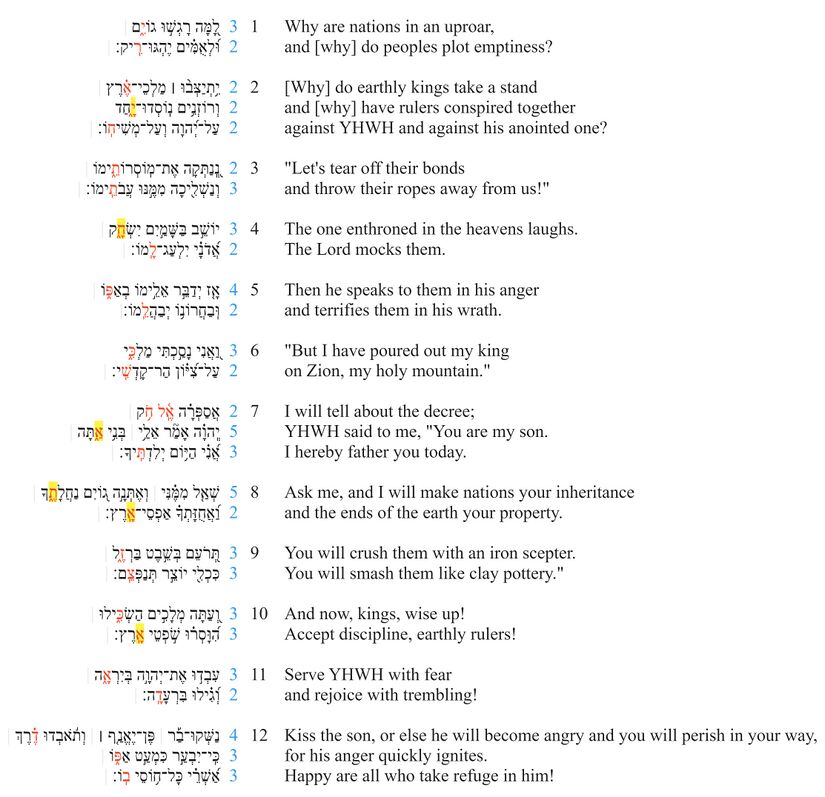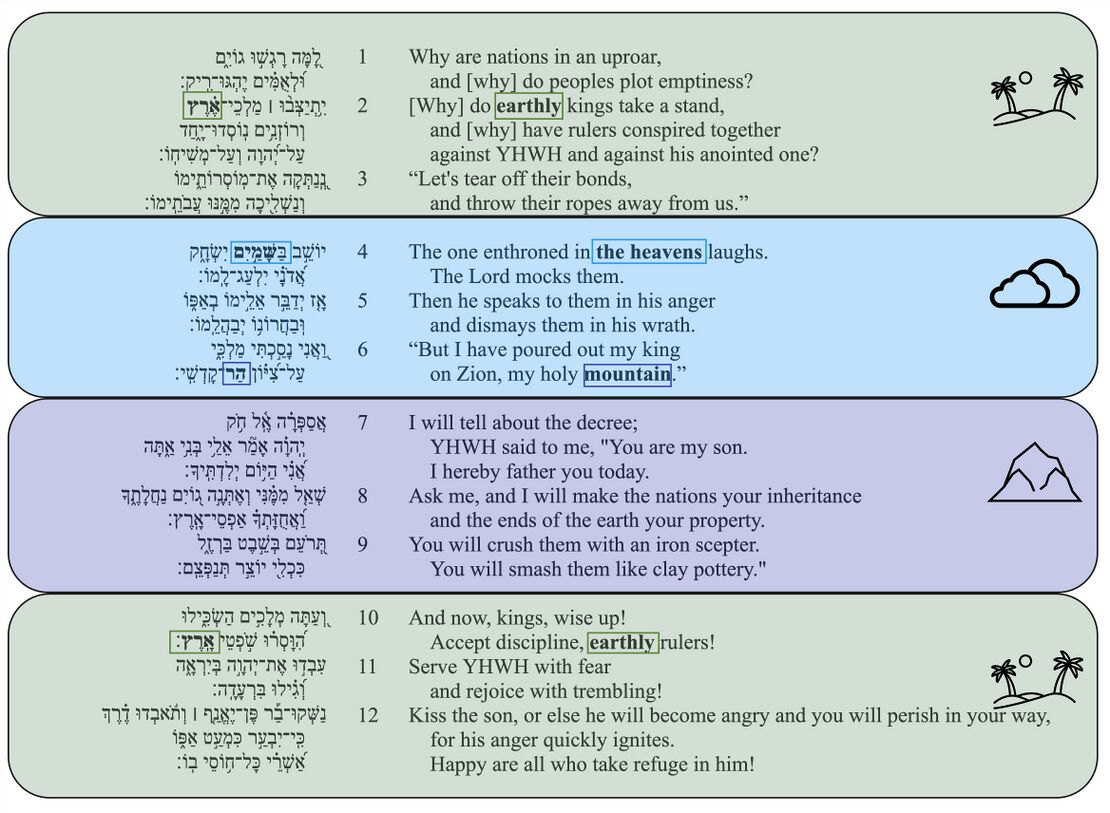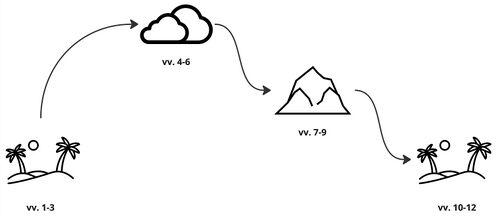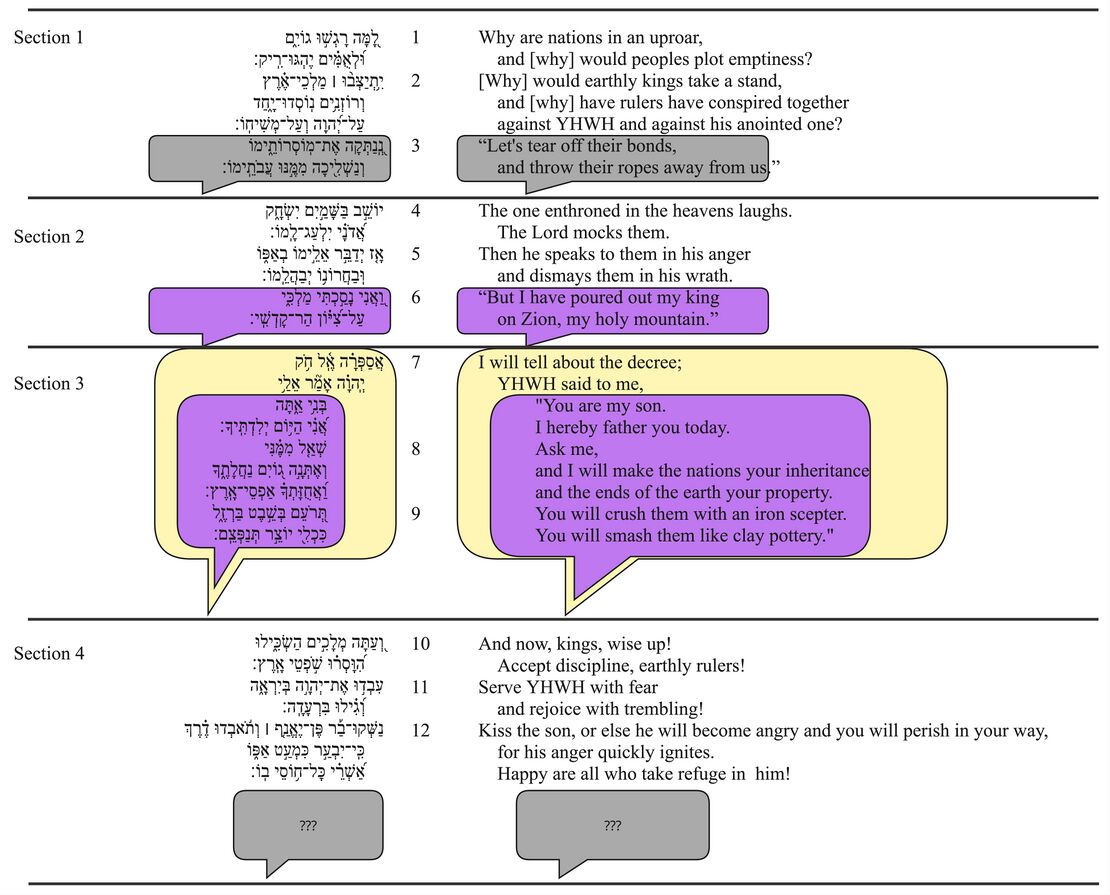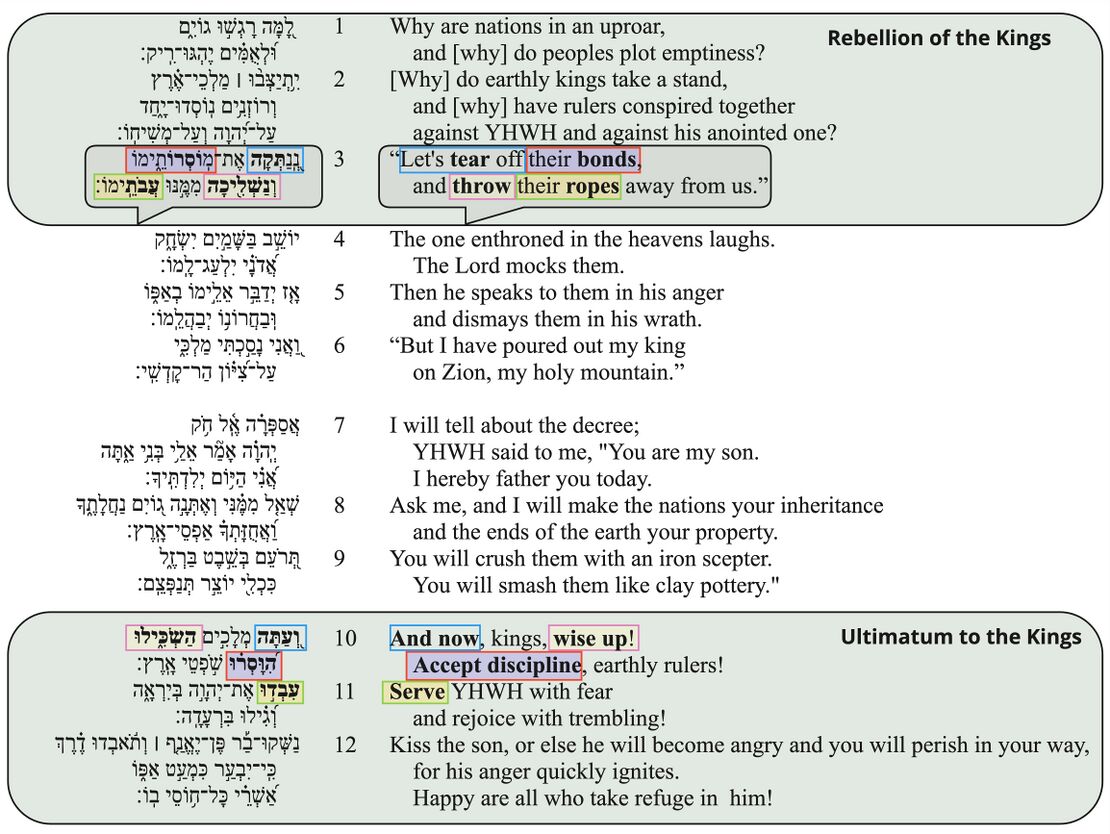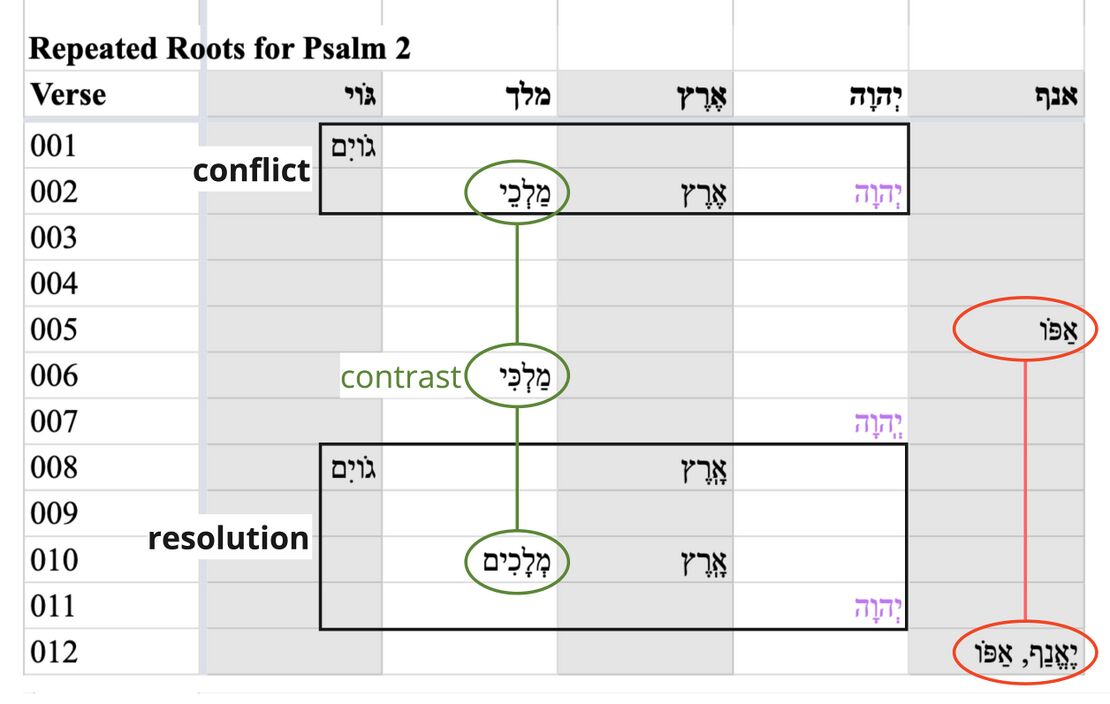Psalm 2 Poetry
About the Poetics Layer
Exploring the Psalms as poetry is crucial for understanding and experiencing the psalms and thus for faithfully translating them into another language. This layer is comprised of two main parts: Poetic Structure and Poetic Features.
Poetic Structure
In poetic structure, we analyse the structure of the psalm beginning at the most basic level of the structure: the line (also known as the “colon” or “hemistich”). Then, based on the perception of patterned similarities (and on the assumption that the whole psalm is structured hierarchically), we argue for the grouping of lines into verses, verses into sub-sections, sub-sections into larger sections, etc. Because patterned similarities might be of various kinds (syntactic, semantic, pragmatic, sonic) the analysis of poetic structure draws on all of the previous layers (especially the Discourse layer).
Poetic Macro-structure
If an emendation or revocalization is preferred, that emendation or revocalization will be marked in the Hebrew text of all the visuals.
| Emendations/Revocalizations legend | |
|---|---|
| *Emended text* | Emended text, text in which the consonants differ from the consonants of the Masoretic text, is indicated by blue asterisks on either side of the emendation. |
| *Revocalized text* | Revocalized text, text in which only the vowels differ from the vowels of the Masoretic text, is indicated by purple asterisks on either side of the revocalization. |
| v. 1 Why are nations in an uproar, and [why] do peoples plot emptiness? | Rebellion | Why do the earthly kings rebel against YHWH and his king? | contempt | |
| v. 2 [Why] do earthly kings take a stand and [why] have rulers conspired together against YHWH and against his anointed one? | ||||
| v. 3 Let's tear off their bonds and throw their ropes away from us! | ||||
| v. 4 The one enthroned in the heavens laughs. The Lord mocks them. | Response | The heavenly king laughs | contempt & awe | |
| v. 5 Then he speaks to them in his anger and terrifies them in his wrath. | ||||
| v. 6 But I have poured out my king on Zion, my holy mountain. | ||||
| v. 7 I will tell about the decree; YHWH said to me, "You are my son. I hereby father you today. | Decree | I, the king on YHWH's mountain, will tell about YHWH's decree | confidence | |
| v. 8 Ask me, and I will make nations your inheritance and the ends of the earth your property. | ||||
| v. 9 You will crush them with an iron scepter. You will smash them like clay pottery. | ||||
| v. 10 And now, kings, wise up! Accept discipline, earthly rulers! | Ultimatum | Wise up, earthly kings! Serve YHWH... Kiss the son! | contempt | |
| v. 11 Serve YHWH with fear and rejoice with trembling! | ||||
| v. 12 Kiss the son, or else he will become angry and you will perish in your way, for his anger quickly ignites. Happy are all who take refuge in him! |
Notes
Psalm 2 has four sections: vv. 1-3; vv. 4-6; vv. 7-9; vv. 10-12. This division is widely accepted. As van der Lugt notes, "The division is so obvious that there is no discussion among scholars about this fact."[1] The main reasons for the four-fold division are as follows:
- Content, discourse topic, illocution. The first section describes the futile rebellion of the earthly nations and their rulers (vv. 1-3); the second section describes the response of YHWH, the Lord enthroned in heaven (vv. 4-6); the third section tells about the decree (vv. 7-9); and the fourth section warns and exhorts the earthly kings (vv. 10-12). The topic of each section is mentioned in the first line of that section (bolded in the visual above). See further Macrosyntax and Speech Act Analysis.
- Similar endings. Each of the first three sections ends with quoted speech. The two-line speech of the nations concludes the first section (v. 3); YHWH's two-line speech in response to the nations concludes the second section (v. 6); and YHWH's seven-clause decree concludes (and constitutes the bulk of) the third section (vv. 7-9). The fact that there is no direct speech concluding the final section might be a poetic feature: how will the nations respond? See further Poetic Features.
- Balance. Each section is three verses long.
These four sections are connected in multiple ways, such that multiple patterns emerge. For example,
- ABBA.
- A...A: There are clear connections between the first and last sections (vv. 1-3 // vv. 10-12),[2] indicating an ABBA chiastic structure.
- Sections 1 and 4 are both about the earthly kings, and both sections use the words "kings" and "earth" (v. 2, v. 10).
- There is a clear thematic reversal: vv. 1-3 describe the nations' rebellion against YHWH and against his anointed, and vv. 10-12 summon the nations to submit to YHWH and his anointed.[3]
- Numerous sound correspondences connect the speech of the kings in v. 3 with the warning to the kings in v. 10. See Poetic Features.
- BB: There is also continuity between the middle sections (vv. 4-6 // vv. 7-9). Both sections present YHWH's speaking to legitimate his king's right to rule.[4]
- Of the various patterns identified here, this pattern (ABBA) brings out the inner logic of the psalm most powerfully in the way it highlights the reversal of the earthly kings in vv. 1-3, 10-12.
- A...A: There are clear connections between the first and last sections (vv. 1-3 // vv. 10-12),[2] indicating an ABBA chiastic structure.
- AABB. In addition to the chiastic structure, there are ways in which the psalm divides into two halves (vv. 1-6; vv. 7-12).
- AA: Some features bind together vv. 1-6.
- The first two sections (vv. 1-3; vv. 4-6) are bound together by their similar endings (vv. 3, 6). Both sections end with quoted speech that is two lines long and not introduced by any quotative frame.[5] Furthermore, the waw beginning the speech in v. 6 explicitly connects this speech to the speech in v. 3. See Macrosyntax.
- The similarity between v. 2c and v. 6c is striking. Both lines begin with the preposition עַל and continue the clause of the previous line: "...against (עַל) YHWH and against (עַל) his anointed one" (v. 2c) // "...on (עַל) Zion, my holy mountain" (v. 6b).
- The repetition of the sound o and, specifically, the suffix מוֹ at the ends of lines (vv. 3a, 3b, 4b, 5b).[6]
- BB: Some features bind together vv. 7-12.
- Both sections mention the "son" (vv. 7b [בן], 12a [בר]).
- Both sections describe the potential destruction of the nations and their kings (vv. 9, 12).
- AA: Some features bind together vv. 1-6.
- ABAB. There are also correspondences between the first and third sections and between the second and fourth sections.[7] E.g.,
- A...A: "nations" (vv. 1a, 8a), "earth" (vv. 2a, 8b), מִן "from" (vv. 3b, 8a)
- B...B: "his anger" (vv. 5a, 12b)
Line Divisions
Line division divides the poem into lines and line groupings. We determine line divisions based on a combination of external evidence (Masoretic accents, pausal forms, manuscripts) and internal evidence (syntax, prosodic word counting and patterned relation to other lines). Moreover, we indicate line-groupings by using additional spacing.
When line divisions are uncertain, we consult some of the many psalms manuscripts which lay out the text in lines. Then, if a division attested in one of these manuscripts/versions influences our decision to divide the text at a certain point, we place a green symbol (G, DSS, or MT) to the left of the line in question.
| Poetic line division legend | |
|---|---|
| Pausal form | Pausal forms are highlighted in yellow. |
| Accent which typically corresponds to line division | Accents which typically correspond to line divisions are indicated by red text. |
| | | Clause boundaries are indicated by a light gray vertical line in between clauses. |
| G | Line divisions that follow Greek manuscripts are indicated by a bold green G. |
| DSS | Line divisions that follow the Dead Sea Scrolls are indicated by a bold green DSS. |
| M | Line divisions that follow Masoretic manuscripts are indicated by a bold green M. |
| Number of prosodic words | The number of prosodic words are indicated in blue text. |
| Prosodic words greater than 5 | The number of prosodic words if greater than 5 is indicated by bold blue text. |
If an emendation or revocalization is preferred, that emendation or revocalization will be marked in the Hebrew text of all the visuals.
| Emendations/Revocalizations legend | |
|---|---|
| *Emended text* | Emended text, text in which the consonants differ from the consonants of the Masoretic text, is indicated by blue asterisks on either side of the emendation. |
| *Revocalized text* | Revocalized text, text in which only the vowels differ from the vowels of the Masoretic text, is indicated by purple asterisks on either side of the revocalization. |
Notes
- All line divisions in the psalm agree with the Masoretic accents as interpreted by de Hoop and Sanders 2022, §6.2. The divisions in vv. 1-11 agree also with the Septuagint according to Rahlfs (1931). (Note, however, that Rahlfs' division of v. 1 goes against most LXX witnesses, which present v. 1 as a single stich.)
- The line division of v. 12, specifically the first half of v. 12, is difficult to determine. At least four different divisions would be plausible:
- One line, following the accents (?)

- Two lines, following the LXX

- Two lines, following the syntax

- Two lines, grouping v. 12a with v. 11b[8]

- One line, following the accents (?)
- The Septuagint's division appears to work against the syntax, according to which פֶּן־יֶאֱנַ֤ף ׀ and וְתֹ֬אבְדוּ דֶ֗רֶךְ are coordinate clauses within the scope of the same subordinating conjunction פֶּן. (The Septuagint's division might also be influenced by the addition of a word at the end of the clause: καὶ ἀπολεῖσθε ἐξ ὁδοῦ δικαίας).
- We could keep the two subordinate clauses together and divide instead after בַ֡ר, but this would result in a very short line: נַשְּׁקוּ־בַ֡ר (one prosodic word, four syllables), which would be the shortest line in the psalm. If, however, we do not divide at all—נַשְּׁקוּ־בַ֡ר פֶּן־יֶאֱנַ֤ף ׀ וְתֹ֬אבְדוּ דֶ֗רֶךְ—, then v. 12a would be the longest line in the psalm (12-14 syllables, depending on how they are counted). In either case, the beginning of v. 12 is marked in terms of its prosodic structure.
- In the end, we have followed the Masoretic accents in dividing v. 12. Jerome (iuxta Hebr.) appears to follow the same division (see Weber-Gryson 5th edition).
Poetic Features
In poetic features, we identify and describe the “Top 3 Poetic Features” for each Psalm. Poetic features might include intricate patterns (e.g., chiasms), long range correspondences across the psalm, evocative uses of imagery, sound-plays, allusions to other parts of the Bible, and various other features or combinations of features. For each poetic feature, we describe both the formal aspects of the feature and the poetic effect of the feature. We assume that there is no one-to-one correspondence between a feature’s formal aspects and its effect, and that similar forms might have very different effects depending on their contexts. The effect of a poetic feature is best determined (subjectively) by a thoughtful examination of the feature against the background of the psalm’s overall message and purpose.
Heaven and Earth and In Between
If an emendation or revocalization is preferred, that emendation or revocalization will be marked in the Hebrew text of all the visuals.
| Emendations/Revocalizations legend | |
|---|---|
| *Emended text* | Emended text, text in which the consonants differ from the consonants of the Masoretic text, is indicated by blue asterisks on either side of the emendation. |
| *Revocalized text* | Revocalized text, text in which only the vowels differ from the vowels of the Masoretic text, is indicated by purple asterisks on either side of the revocalization. |
Feature
The first section of the Psalm (vv. 1-3) is about the "kings of earth" (v. 2a). Similarly, the last section of the Psalm (vv. 10-12) is addressed to the "rulers of earth" (v. 10b). The second section (vv. 4-6) is about YHWH, referred to as the "one who rules in the heavens" (v. 4a). The third section (vv. 7-9) is spoken by the king who is on YHWH's "holy mountain" (v. 6b), the meeting place between heaven and earth.
The movement of the Psalm is from earth up to heaven and then downward (heaven --> mountain --> earth).
Effect
The Psalm takes on the character of a cosmic drama. At the beginning of the psalm, the earthly kings are rebelling against the ruler of heaven, and at the end of the psalm they are summoned to submit to God’s king on Zion, and thereby submit to the king of heaven. The center of the drama—and the point where the conflict is resolved—is Mt. Zion, the meeting place between heaven and earth. This is the place where YHWH’s heavenly rule comes to bear on earth, the place where YHWH’s anointed ruler is placed as king.
Dramatic Conversation
If an emendation or revocalization is preferred, that emendation or revocalization will be marked in the Hebrew text of all the visuals.
| Emendations/Revocalizations legend | |
|---|---|
| *Emended text* | Emended text, text in which the consonants differ from the consonants of the Masoretic text, is indicated by blue asterisks on either side of the emendation. |
| *Revocalized text* | Revocalized text, text in which only the vowels differ from the vowels of the Masoretic text, is indicated by purple asterisks on either side of the revocalization. |
Feature
Psalm 2 features multiple speakers. The psalm begins and ends with an anonymous psalmist speaking (see Participant Analysis). In v. 3, the nations speak; in v. 6, YHWH speaks; and in vv. 7-9, the king speaks and quotes YHWH's decree (vv. 7b-9).
The embedded speeches occur at seams in the poetic structure. Each of the first three sections (vv. 1-3; vv. 4-6; vv. 7-9) end with an embedded speech (see Poetic Structure). The only section that does not have direct speech is the final section (vv. 10-12).
Effect
The speeches are part of what make Ps 2 unique compared to other poems in the Psalter. In particular, the speeches give the psalm "a dramatic character."[9] It is as though we are watching a play in which each of the major characters has a speaking part.
The pattern of each section concluding with a speech leads us to expect a speech at the end of the fourth section. Instead, there is no speech, and the fourth section concludes with an ultimatum to the earthly kings. We are left wondering what the nations will say in response. Will they accept the king's dominion and join those who "take refuge in him" (v. 12c), or will they continue their rebellion and perish in their way (v. 12b)?
Think Again
If an emendation or revocalization is preferred, that emendation or revocalization will be marked in the Hebrew text of all the visuals.
| Emendations/Revocalizations legend | |
|---|---|
| *Emended text* | Emended text, text in which the consonants differ from the consonants of the Masoretic text, is indicated by blue asterisks on either side of the emendation. |
| *Revocalized text* | Revocalized text, text in which only the vowels differ from the vowels of the Masoretic text, is indicated by purple asterisks on either side of the revocalization. |
Feature
In the first section of the psalm (vv. 1-3), the psalmist describes the rebellion of the earthly kings, and he presents their rebellious words (v. 3). Then, in the last section of the psalm, he issues an ultimatum to the kings, calling them to reverse their behavior (vv. 10-12).
Several of the words near the beginning of this final section (vv. 10-12) sound similar to the words from the nations' speech in v. 3. In fact, every verb and noun from the nation's speech in v. 3 has some echo in vv. 10-11.
- נַשְׁלִ֖יכָה (v. 3) // הַשְׂכִּ֑ילוּ (v. 10) - similar sounds (sh/s + l + k), also only two hiphil verbs in the psalm
- מֽוֹסְרוֹתֵ֑ימוֹ (v. 3) // הִ֝וָּסְר֗וּ (v. 10) - similar sounds (samek + r + o/u vowel)
- עֲבֹתֵֽימוֹ (v. 3) // עִבְד֣וּ (v. 10) - similar sounds (ayin + bet + dental [t/d])
- נְֽ֭נַתְּקָה (v. 3) // וְ֭עַתָּה (v. 10) - similar sounds (plosive tav, -ah ending. Note also that ע and ק might have sounded similar in biblical Hebrew; for example, ע sometimes had a g sound).
Effect
The address to the earthly kings in vv. 10-12 recycles the same sounds that the kings used in their own speech in v. 3. The echo of this previous rebellious speech underscores the reversal in behavior that the psalmist is calling for in vv. 10ff. He contrasts what they are doing and saying (v. 3) with what they should be doing and saying (vv. 10ff). Instead of "throwing off" the "ropes" of YHWH and his anointed (v. 3b), the kings should "wise up" and "serve" them (vv. 10-11a). Instead of "tearing off" "their bonds" (v. 3a) they should "now... accept discipline" (v. 10). Their original declaration of independence (v. 3) is futile, and they are called to change their defiant posture to one of submission and service.
Repeated Roots
The repeated roots table is intended to identify the roots which are repeated in the psalm.
| Repeated Roots legend | |
|---|---|
| Divine name | The divine name is indicated by bold purple text. |
| Roots bounding a section | Roots bounding a section, appearing in the first and last verse of a section, are indicated by bold red text. |
| Roots occurring primarily in the first section are indicated in a yellow box. | |
| Roots occurring primarily in the third section are indicated in a blue box. | |
| Roots connected across sections are indicated by a vertical gray line connecting the roots. | |
| Section boundaries are indicated by a horizontal black line across the chart. | |
Notes
- Verses 1-2 (boxed in black) present the conflict of the psalm: the "nations" and the "kings" of "earth" are rebelling against "YHWH." Verses 8-11 then describe the resolution of this conflict using some of the same words: the "nations" and the "earth" become the property of YHWH's anointed, and the "kings" and rulers of "earth" serve "YHWH."
- The three-fold repetition of the word "king" (circled in green) highlights a contrast: YHWH's "king" (v. 6) vs the "kings" of earth (vv. 2, 10).
- The repetition of the root אנף ("anger"; circled in red) in v. 5 and v. 12 draws a comparison between YHWH and YHWH's king. Both respond to the nation's rebellion with "anger."
Bibliography
- Andrason, Alexander. 2012. “Making It Sound - The Performative Qatal and Its Explanation.” The Journal of Hebrew Scriptures 12 (October): 1–58.
- Baethgen, Friedrich. 1904. Die Psalmen. Göttingen: Vandenhoeck und Ruprecht.
- Cook, John A. 2024. The Biblical Hebrew Verb: A Linguistic Introduction. Learning Biblical Hebrew. Grand Rapids: Baker Academic.
- Craigie, Peter C. 1983. Psalms 1–50. WBC 19. Waco, TX: Word.
- Creach, Jerome F. D. 1996. Yahweh as Refuge and the Editing of the Hebrew Psalter. A&C Black.
- Delitzsch, Franz. 1996. “Psalms.” In Commentary on the Old Testament, translated by James Martin. Peabody, Mass.: Hendrickson.
- Eaton, J. H. 1975. Kingship and the Psalms. London: S.C.M. Press.
- Fokkelman, J. P. 2000. Major Poems of the Hebrew Bible: At the Interface of Hermeneutics and Structural Analysis. Studia Semitica Neerlandica. Assen, The Netherlands: Van Gorcum.
- Garr, W. Randall. 2003. In His Own Image and Likeness : Humanity, Divinity, and Monotheism. Leiden ; Boston: Brill.'
- Gentry, Peter J. 1998. “The System of the Finite Verb in Classical Hebrew.” Hebrew Studies 39:7–39.
- Gesenius, W. Donner, H. Rüterswörden, U. Renz, J. Meyer, R. (eds.). 2013. Hebräisches und aramäisches Handwörterbuch über das Alte Testament. 18. Auflage Gesamtausgabe. Berlin: Springer.
- Goldingay, John. 2006. Psalms: Psalms 1–41. Vol. 1. BCOT. Grand Rapids: Baker Academic.
- Hengstenberg, Ernst Wilhelm. 1863. Commentary on the Psalms. Vol. 1. Edinburgh: T. & T. Clark.
- Herion, Gary A. 1992. “Wrath of God (OT).” In Anchor Bible Dictionary, edited by David Noel Freedman, 6:989–96. New York: Doubleday.
- Hilber, John. 2009. “Psalms.” In Zondervan Illustrated Bible Backgrounds Commentary: The Minor Prophets, Job, Psalms, Proverbs, Ecclesiastes, Song of Songs, edited by John Walton. Vol. 5. Grand Rapids, MI: Zondervan.
- Hoffmeier, James. 1994. “The King as Son of God in Egypt and Israel.” The Journal of the Society for the Study of Egyptian Antiquities 24:28–38.
- Hossfeld, Frank-Lothar, and Erich Zenger. 1993. Die Psalmen I: Psalm 1–50. Neue Echter Bibel. Würzburg: Echter.
- Hupfeld, Hermann. 1855. Die Psalmen. Vol. 1. Gotha: Friedrich Andreas Perthes.
- Ibn Ezra. Ibn Ezra on Psalms.
- Jenni, Ernst. 2000. Die hebräischen Präpositionen Band 3: Die Präposition Lamed. Stuttgart: Verlag W. Kohlhammer.
- Jones, G H. 1965. “The Decree of Yahweh (Ps. II 7).” Vetus Testamentum 15 (3): 336–44.
- Kim, Young Bok. 2023. Hebrew Forms of Address: A Sociolinguistic Analysis. Atlanta: SBL Press. vvo.
- Lugt, Pieter van der. 2006. Cantos and Strophes in Biblical Hebrew Poetry: With Special Reference to the First Book of the Psalter. Vol. 1. 3 vols. Oudtestamentische Studiën 53. Leiden: Brill.
- Malbim. Malbim on Psalms.
- Mena, Andrea K. 2012. “The Semantic Potential of עַל in Genesis, Psalms, and Chronicles.” MA Thesis, Stellenbosch University.
- Murnane, William Joseph, and Edmund S. Meltzer. 1995. Texts from the Amarna Period in Egypt. Writings from the Ancient World 5. Atlanta: Scholars Press.
- Niccacci, Alviero. 2006. “The Biblical Hebrew Verbal System in Poetry.” In Biblical Hebrew in Its Northwest Semitic Setting: Typological and Historical Perspectives, edited by Steven E. Fassberg and Avi Hurvitz, 247–68. Publication of the Institute for Advanced Studies, the Hebrew University of Jerusalem 1. Jerusalem: Hebrew University Magnes Press.
- Penney, Jason. 2023. “A Typological Examination of Pluractionality in the Biblical Hebrew Piel.” MA, Dallas: Dallas International University.
- Poole, Matthew. 1678. Synopsis Criticorum Aliorumque Sacrae Scripturae. Vol. 2: a Jobi ad Canticum Canticorum.
- Raabe, Paul. 1991. “Deliberate Ambiguity in the Psalter.” Journal of Biblical Literature 110 (2): 213–27.
- Radak. Radak on Psalms.
- Radner, Karen. 2016. “3 Revolts in the Assyrian Empire: Succession Wars, Rebellions Against a False King and Independence Movements.” In Revolt and Resistance in the Ancient Classical World and the Near East, edited by John J. Collins and J.G. Manning, 39–54. Brill.
- Rashi. Rashi on Psalms.
- Ringgren, Helmer. 1983. “Psalm 2 and Bēlit’s Oracle for Ashurbanipal.” In The Word of the Lord Shall Go Forth, edited by Carol L Meyers and M. O’Connor, 91–95. Winona Lake: Eisenbrauns.
- Robar, Elizabeth. 2015. The Verb and the Paragraph in Biblical Hebrew: A Cognitive-Linguistic Approach. Vol. 78. Studies in Semitic Languages and Linguistics. Leiden: Brill.
- Robar, Elizabeth. 2022. “Morphology and Markedness: On Verb Switching in Hebrew Poetry: SBL Annual Meeting 2020 Linguistics and Biblical Hebrew Seminar: Typological and Grammatical Categorization of Biblical Hebrew.” Journal for Semitics 30 (2).
- Tatu, Silviu. 2006. “The Rhetorical Interpretation of the Yiqtol//Qatal (Qatal//Yiqtol) Verbal Sequence in Classical Hebrew Poetry and Its Research History.” Transformation: An International Journal of Holistic Mission Studies 23 (1): 17–23.
- Tsumura, David Toshio. 2023. Vertical Grammar of Parallelism in Biblical Hebrew. Ancient Israel and Its Literature 47. Atlanta: SBL Press.
- Victor, Peddi. 1966. “Note on Choq in the Old Testament.” Vetus Testamentum 16 (3): 358–61.
- Walton, John H. 2018. Ancient Near Eastern Thought and the Old Testament: Introducing the Conceptual World of the Hebrew Bible. Second edition. Grand Rapids, Michigan: Baker Academic, a division of Baker Publishing Group.
- Weber, Beat. 2016. Werkbuch Psalmen. 1: Die Psalmen 1 bis 72. Zweite aktualisierte Auflage. Stuttgart: Verlag W. Kohlhammer.





